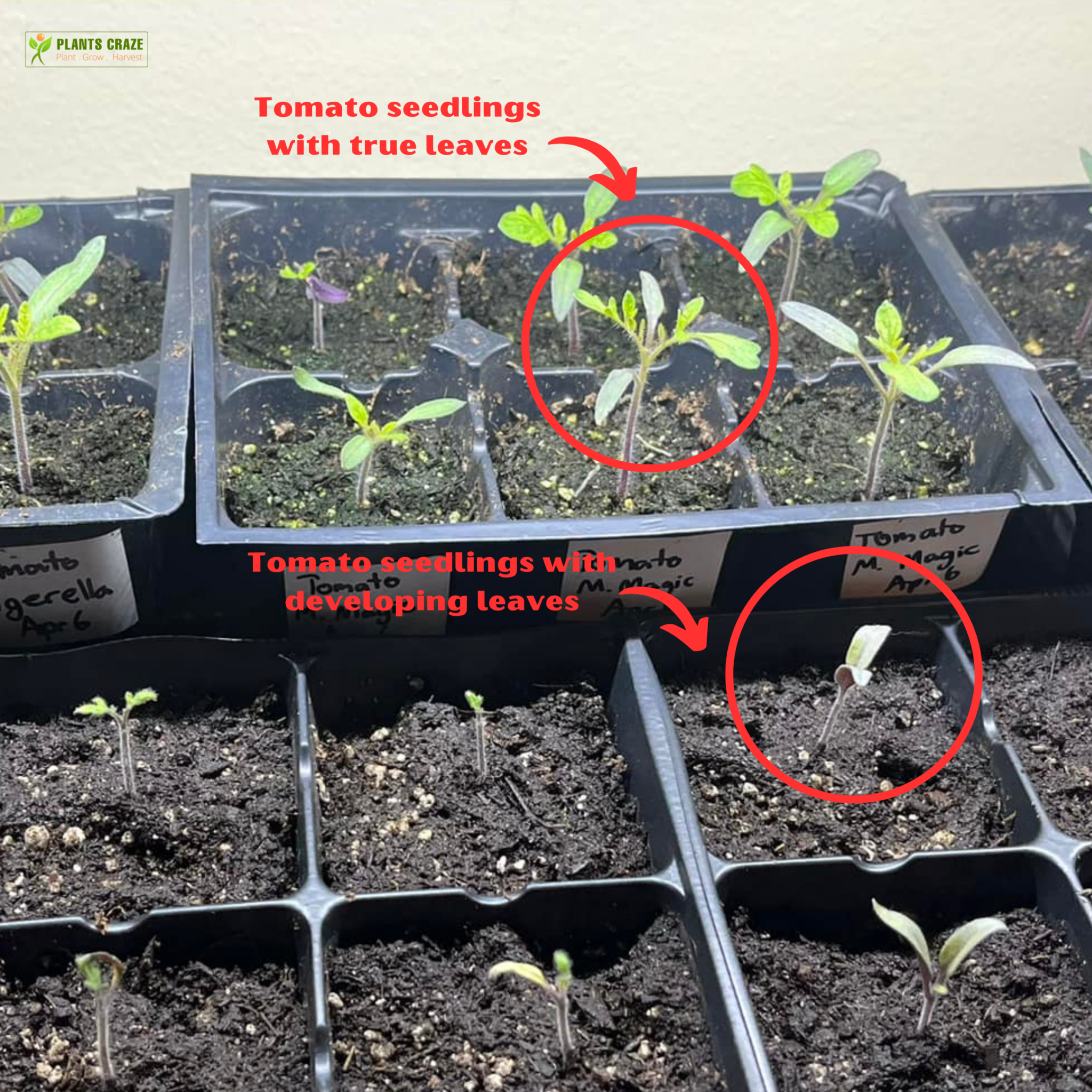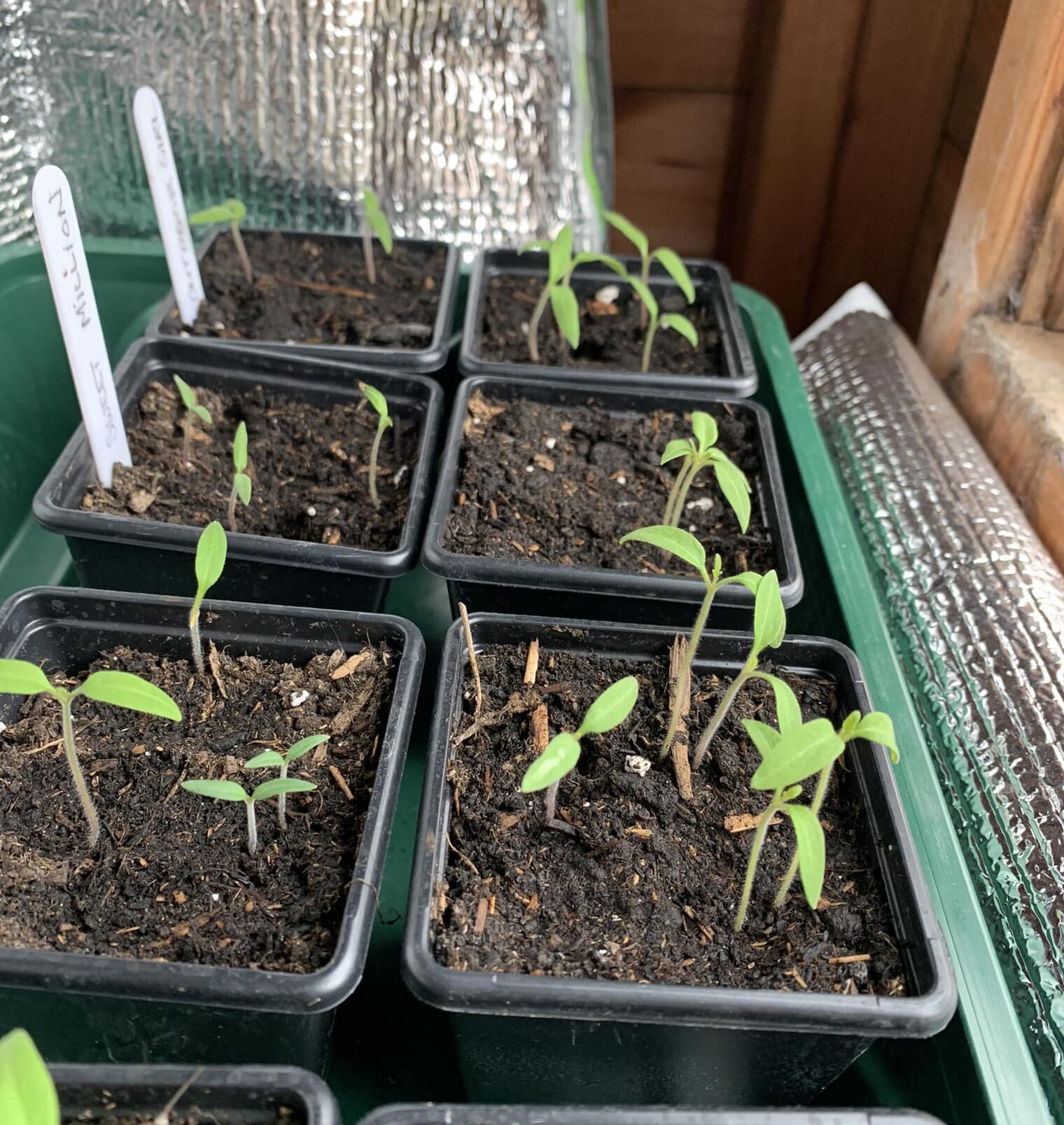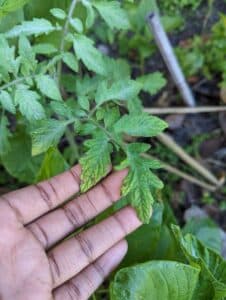Do you know fresh tomato seeds have around 90% germination rate success, sprouting easily without any issues?
But once they mature into tomato seedlings, they may face many muddles along their growth course!
To cater to these doubts about tomato seedling problems, let us go through the possible causes and solutions.
Table of Contents Show
10+ Tomato Seedling Problems [With Solutions]
Growing tomato seedlings from seeds take at least 6-8 weeks from sowing to transplanting.
However, it takes about 4-14 days for tomato seeds to sprout when provided with conducive conditions.

Once 25-35 days into the early growth stage, tomato seedlings gain a true set of leaves and roots sturdy enough for transplanting.
Hence, they must be looked after like mature tomato plants.
Without proper care, tomato seedlings face many problems, which we will discuss along with their causes and quick solutions below.
1. Droopy or Wilting Tomato Seedlings
Causes
- Overwatering during fall and winter – soggy soil, lack of oxygen within the potting environment, and root rot
- Underwatering during spring and summer – arid soil, inability to transport nutrients, and lack of water for the tomato seedlings
Solutions
- Water daily with 0.3 inches and 1-2 inches weekly during spring and summer.
- Refrain watering during fall and winter to prevent the seedlings from drowning.
- Check the top 6-8 inches of soil for dryness before watering.
- Amend the soil with porous ingredients like organic perlite to increase drainage.
2. Purple Tomato Seedling Problem
Causes
- Potassium or phosphorous deficiency – reddish-purple leaves and veins
- Viral and pest infestation – weak and droopy leaves
- Leaf burns – browning or purpling of leaf edges and tips
Solutions
- Opt for high potassium and phosphorous-rich fertilizers weekly in spring and summer, or incorporate the soil with bone meal.
- Prune diseased parts or discard the whole plant in case of severe viral diseases like Tomato Mosiac Virus (ToMV), Cucumber Mosiac Virus (CMV), and Tobacco Mosiac Virus (TMV).
- Protect the seedlings from direct sunlight and keep them in a shady spot for a few days to recover.
3. Stalled Growth Rate
Causes
- Close spacing – competition between the seedlings for nutrients, light, and water
- Weak sunlight – less photosynthesis and energy production for vertical growth
- Low and high temperatures – less foliage and flower production
- Lack of humidity and moisture – foliar contraction

Solutions
- Keep at least 1-2 feet of space between the seedlings while planting.
- Offer at least 6-8 hours of sunlight daily to the seedlings.
- Place the seedlings on heating mats maintained at 65-85°F.
- Maintain ambient humidity of around 65-90%.
4. White Patches On Tomato Seedlings
Causes
- Extreme humidity with poor air circulation – powdery mildew stirring white patches on leaves
- High nitrogen or phosphorous in the soil – whitish-brown discoloration triggered by fertilizer burn
- Extreme heat or cold stress – sunscalding of exposed parts (leaves and stems)

Solutions
- Maintain a relative humidity of around 60-85% using humidifiers or humidity trays.
- Use fertilizers with less nitrogen or phosphorous, or halt feeding until the symptoms subside.
- Protect the seedlings from cold stress using frost blankets in winter.
- Use fresh potting mix and repot the seedlings to discard the pathogens from old soil.
5. Brown Leaves or Spots
Causes
- Imprudent or underwatering – visible brown patches on the tomato leaves
- Early blight – concentric brown spots or blotches on the leaves due to acute soil wetness
Solutions
- Prevent overhead watering and maintain a porous potting environment.
- Prune off infected leaves and use foliar fungicides to tend the seedlings.
- Permeate holes on the topsoil to offer a boost of drainage for the plantlings.
6. Yellow Leaves On Tomato Seedlings
Causes
- Nitrogen, potassium, and magnesium deficiency – entire or older leaves turning yellow
- Lack of oxygen in the soil – mushy soil due to overwatering suffocate the roots
- Transplanting stress – inability to adapt quickly to a new potting environment
Solutions
- Use fertilizers with high nitrogen or phosphorous or foliar sprays and soil additives of Epsom salts for magnesium.
- Thin or transplant tomato seedlings when they are 3-4 inches tall and have 3 or more sets of true leaves.
- Lay pebbles at the pot’s base during transplants to encourage percolation.
7. Leggy Tomato Seedling Problems
Causes
- Lack of natural or artificial lighting – leaves and stems stretching towards the sunlight source
- Crowded and warm growth conditions – foliage unnecessarily extending for bright light
- Erratic watering and high fertilizer use – extensive stem and leaf length due to overnutrition

Solution
- Situate the seedlings about 6-12 inches away from the grow lights for 12-16 hours daily to cope with the lack of sunlight.
- Maintain spacing between the seedlings or trim some spent leaves to improve airflow.
- Avoid using fertilizers that improve the foliar appearance of the plant or dilute the fertilizer for minimal use.
8. Curling and Brittle Tomato Seedling Leaves
Causes
- High summer heat – soil moisture loss and shriveling of plant leaves (physiological leaf roll)
- Die backs – leaf burns and expulsion of water from the tissues
- Curly tops – rolling or bending of top leaves
Solutions
- Keep the seedlings in a shady spot to revive the wilted leaves.
- Maintain ample soil moisture and keep the soil damp but not soggy during summer.
9. Black Fungus
Causes
- Tomato leaf mold – the appearance of yellow patches and black fuzzy spots on the leaves
- Honeydews left by pests – a suitable breeding ground for sooty molds
Solutions
- Install sticky traps around the plantlings to slay hovering pests like whiteflies and thrips.
- Use Q-tips laced with neem oil to wipe out the visible pests from the seedlings.
10. Fungal Disease Problems
Causes
- Botrytis: Patches of black decay on leaves and stems
- Damping off: Droopy and yellow foliage
Solution
- You can apply copper fungicides for fungal problems as instructed per pack.

11. Abrupt Seedling Hardening
Causes
- Relocation or transplant stress – yellow leaves and droopy leaf stalks with stems
Solutions
- Begin hardening tomato seedlings when they are about 1 month old.
From Editorial Team
Conclusion!
Tomato seedlings are delicate and must be given the correct warmth, temperature, light, and watering during their growth phase.
Hence, they need frost protection if you grow them indoors during winter and later transplant them in warm soil at 65-70°F.


